| The Ordering subsystem contains those classes and relationships that deal with the process of ordering merchandise from the bookstore. The class diagram for this subsystem is shown in Figure B.2. Figure B.2. Ordering Subsystem Class Diagram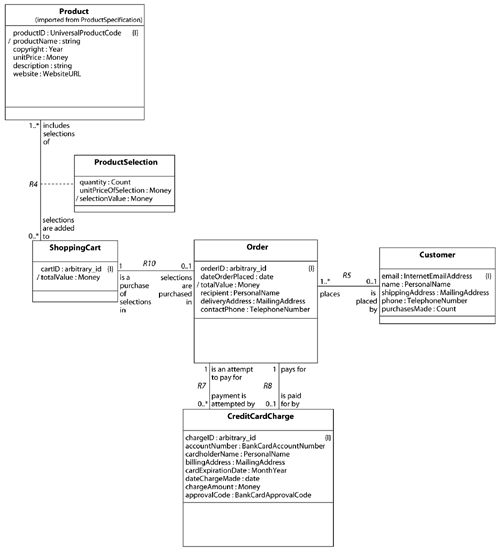
Customer A customer is an individual or organization that has placed orders for books and other products offered by the store. A customer must have purchased books; a user who simply browses to the site is not considered a customer until he or she places an order. Customers remain active for six months after their last order. An active customer receives periodic e-mail reminders of sales and can be eligible for discounts based on how much he or she has previously purchased. Attributes email: InternetEmailAddress The customer's e-mail address, also used as the customer's login and unique identifier. name: PersonalName The customer's name. shippingAddress: MailingAddress The address to which the customer's orders are normally sent. phone: TelephoneNumber The customer's telephone number. purchasesMade: Count How many purchases the customer has made since becoming a customer. Associations & Relationships R5 PLACES 1..* Order Customers place orders for products. An order that is not yet checked out does not have to be associated with a customer, but every customer must have placed at least one order. Order An order is a request to purchase one or more books. An order is started when a customer checks out a shopping cart by specifying a credit card number and shipping address. If the credit card charge is approved, the contents of the order are shipped to the customer. State Machine See Figure B.3. Figure B.3. Order Statechart 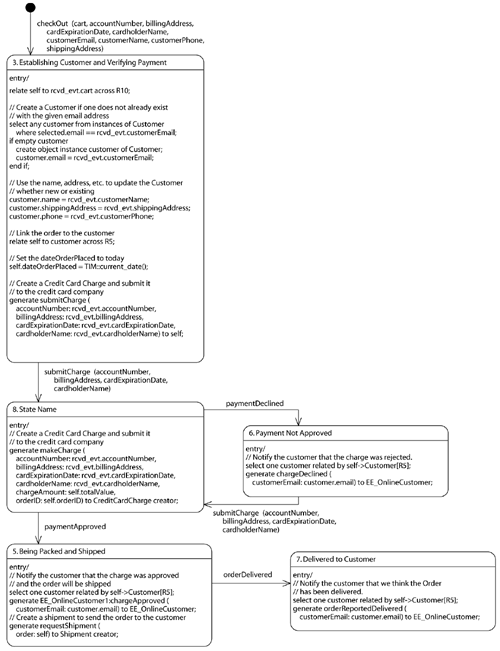
Attributes orderID: arbitrary_id A unique number assigned by the bookstore to the order. dateOrderPlaced: date The date the order was started when a shopping cart is checked out. In some instances, this may be different from the date that the order is shipped. totalValue: Money The total value of the order: the sum of all of the product selections on the order. The bookstore does not collect tax or shipping charges on orders. recipient: PersonalName The name of the person to whom the order is to be shipped. This is generally the same as the customer, but a customer may place an order to be shipped to someone else (as a gift, for example). deliveryAddress: MailingAddress The location where the order is to be shipped. contactPhone: TelephoneNumber A telephone number to contact someone (generally, the customer) in case of problems or questions about the order, the charge, or the shipments. Associations & Relationships R8 IS PAID FOR BY 0..1 CreditCardCharge Each order must be paid for using a credit card. When the order is checked out, a credit card charge is created and submitted for approval (association R7). Only if the charge is approved (and therefore actually pays for the order) is this association created. Consequently, there may be many attempts (R7) but only one actual payment (R8). R6 IS SENT TO CUSTOMER AS 0..1 Shipment When an order's payment is approved, a Shipment is created and associated to the Order. R5 IS PLACED BY 0..1 Customer Customers place orders for products. An order that is not yet checked out does not have to be associated with a customer, but every customer must have placed at least one order. R7 PAYMENT IS ATTEMPTED BY 0..* CreditCardCharge When a customer checks out an order, he provides a credit card number, expiration date, and such. This information is submitted to the credit card company, who may approve or decline the charge. This association represents the attempted charge: An instance of this association is created each time a charge is submitted to pay for an order, regardless of whether or not the charge is actually approved. Contrast this with association R8, the actual payment. R10 IS A PURCHASE OF SELECTIONS IN 1 ShoppingCart The Shopping Cart is distinct from the Order. The Shopping Cart has Product Selections added to and removed from it. The Order, on the other hand, is not placed until the Shopping Cart is checked out. ProductSelection Each ProductSelection represents a single selection by a customer of products in a shopping cart. A ProductSelection is created each time a customer adds a product to a cart. State Machine See Figure B.4. Figure B.4. ProductSelection Statechart 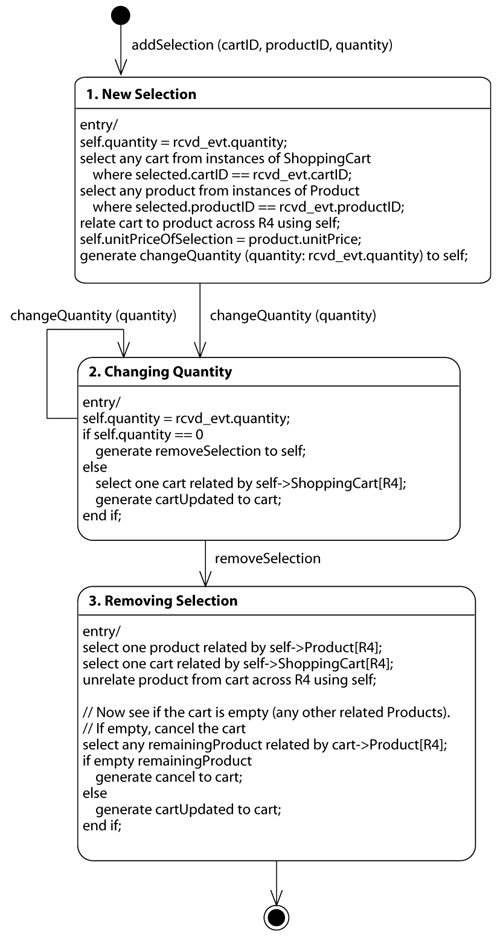
Attributes quantity: Count The quantity of the related product that the customer has selected. unitPriceOfSelection: Money Represents the unit price of a product added to a shopping cart at the time the product is selected and added to the cart. This attribute is initialized with Product.unitPrice but is kept separately so as to capture the price the customer actually pays even if the actual product price changes. selectionValue: Money The total price of the selection. Associations & Relationships R9 IS INCLUDED IN 0..* Shipment When an order is paid for, the selections in the order are shipped to the customer. This association identifies which selections are shipped in which shipment. Some selections are not shipped from the bookstore because they are selections of special-order products shipped directly from the publisher. It is even possible for a paid order to have no shipment. However, a shipment must contain at least one selection. Future versions of this system will also support partial shipments in which items are shipped only when there is sufficient stock on hand. In that situation, we will need to identify which shipments contain which selections. This association will capture this information. R4 formalizes association between Product and ShoppingCart Each time a customer makes a selection, the customer's cart is linked to the corresponding selection, creating an instance of a ProductSelection. ShoppingCart A shopping cart contains a customer's product selections. A cart is started when a customer selects a first product. Additional products may be added to the cart. The customer then checks out the cart to place an order. State Machine See Figure B.5. Figure B.5. ShoppingCart Statechart 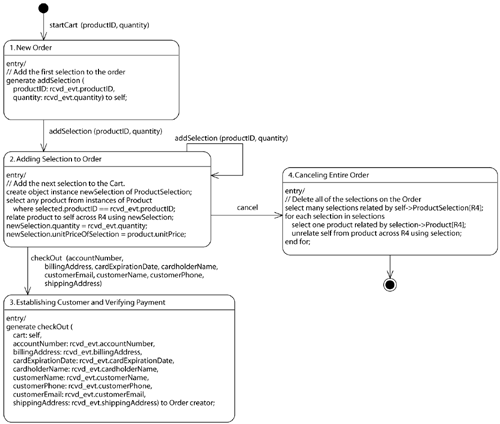
Attributes cartID: arbitrary_id An arbitrary ID to refer to a specific cart. totalValue: Money The total value of all of the items in the cart. Associations & Relationships R4 INCLUDES SELECTIONS OF 1..* Product Each time a customer makes a selection, the customer's cart is linked to the corresponding selection, creating an instance of a ProductSelection. R10 SELECTIONS ARE PURCHASED IN 0..1 Order The Shopping Cart is distinct from the Order. The Shopping Cart has Product Selections added to and removed from it. The Order, on the other hand, is not placed until the Shopping Cart is checked out. CreditCardCharge All purchases are paid by credit card. A credit card charge is created when an order is placed. The charge is submitted to the bookstore's credit card processing company. This company either approves or declines the charge. When the charge is approved, the order can be packed and shipped to the customer. State Machine See Figure B.6. Figure B.6. CreditCardCharge Statechart 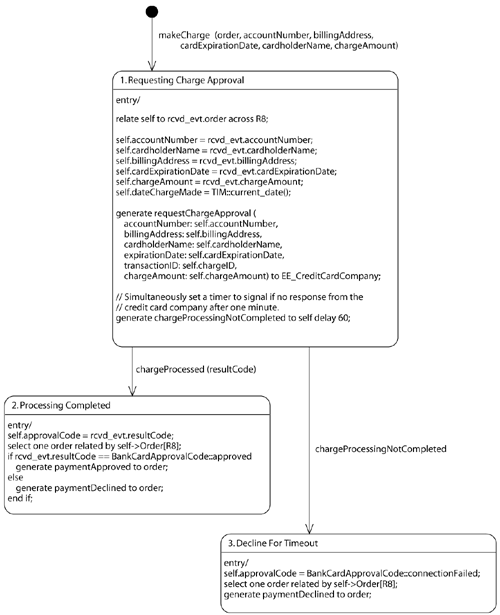
Attributes chargeID: arbitrary_id A unique identifier assigned by the bookstore to the charge submission. accountNumber: BankCardAccountNumber The credit card account to be charged. cardholderName: PersonalName The name of the accountholder as it appears on the credit card. billingAddress: MailingAddress The billing address on the credit card account. The credit card processing company compares this to the account's billing address to ensure that the charge submission is correct. cardExpirationDate: MonthYear The expiration date as shown on the credit card. The credit card processing company compares this to the account's expiration date to ensure that the charge submission is correct. The processing company will not accept a charge for an expired card, even if a future (but incorrect) expiration date is submitted. dateChargeMade: date The date that the charge is sent for processing. chargeAmount: Money The amount of the charge submitted for processing. Normally this is the same as the totalValue of the related order. approvalCode: BankCardApprovalCode The result code returned from the credit card processing. See the definition of the datatype BankCardApprovalCode for the possible values of this attribute. Associations & Relationships R8 PAYS FOR 1 Order Each order must be paid for using a credit card. When the order is checked out, a credit card charge is created and submitted for approval (association R7). Only if the charge is approved (and therefore actually pays for the order) is this association created. Consequently, there may be many attempts (R7) but only one actual payment (R8). R7 IS AN ATTEMPT TO PAY FOR 1 Order When a customer checks out an order, he provides a credit card number, expiration date, and such. This information is submitted to the credit card company, who may approve or decline the charge. This association represents the attempted charge: An instance of this association is created each time a charge is submitted to pay for an order, regardless of whether or not the charge is actually approved. Contrast this with association R8, the actual payment. |




